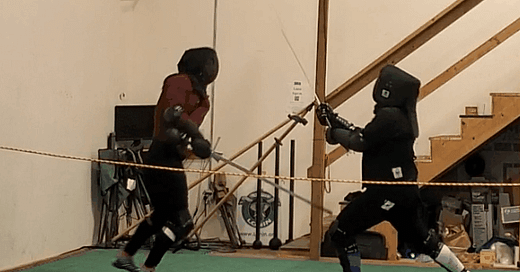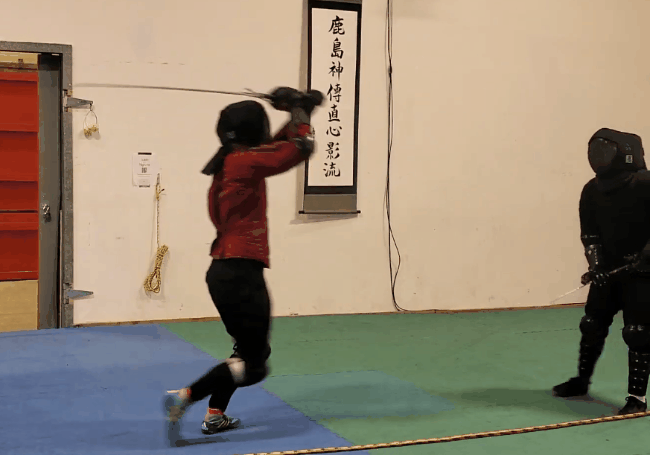Opinion: Flat strikes in Longsword are great, and you should score them
Promoting proper prellhaus
Wait wait wait, don’t count me out yet. I have good reasons for my opinion, not that I primarily study Meyer or get irked when a point gets thrown out during a tournament. I seriously believe that flat strikes with a longsword should be scored in tournaments, and I want to use this space to outline why. I’ll be using some of the common arguments against scoring striking with the flat to illustrate my thoughts.
First, some definitions…
When I say flat strikes with a longsword I’m actually being a little more narrow than those two words illustrate, with 2 main criteria being built into my definition.
The flat strike is a purposeful strike performed by a fencer, not a mechanical mistake (ie. a zwerch which you flail out flat).
The good flat strike is to the head or hands, not to the torso, thigh, etc.
Argument 1: My source doesn’t have flat strikes or “prellhaus” in it
You don’t need to teach flat strikes or reconcile them with whatever fencing treatise/system/master you have at your club or simply enjoy fencing. Rather, I believe that no matter what treatise you study, a tournament ruleset should be designed to encompass fencers from diverse backgrounds and training styles, and including flat strikes as a scoring action increases the interesting tactical choices fencers can make at your event. If you are trying to do a Fiore-Only event, then sure, count ‘em out. This is for the Longpoint’s of the world, big events with extremely wide reach, not small targeted affairs that may have different goals.
Argument 2: Flat strikes aren’t “martially valid, fight-ending, and/or wouldn’t cut your opponent’s head off.”
I don’t care.
Striking with the flat purposefully is an interesting and valid tactical choice by a fencer, expands both the toolbox of the attacking fencer and creates additional choices for a defending fencer in how they choose to parry, and requires skill to execute consistently. Fencer A noticing that Fencer B is tending to parry very close to their head and exploiting this trend by throwing a flat strike and hitting them around their blade is a complex and interesting fencing action, and should be rewarded.
Over the years I have started moving away from attempting to frame general tournament rules after hypothetical “real fights,” shifting to defining simple criteria for success I want fencers to shoot for, and rewarding fencing actions that match them. I don’t care if a cut to the arm “with a live sharp blade in a judicial duel” could cut their brachial artery or sever tendons, if a thrust needs 5 inches of bend in order to simulate running someone through, or other fantastical criteria for fencing. I care about making ideal choices in a fencing match, and rewarding competitors who make more better choices than their opponent, not pseudo-LARPing.
Argument 3: Allowing flat strikes will create an arms race towards longer floppier feders
Prove it.
There has been a trend over the last 6 years towards more flexible feders, as spearheaded by Sigi, as primarily a response to creating a safer feder in the thrust. Has this caused a mad rush towards learning prellhaus, tournaments needing to put in all caps “NO FLAT STRIKES PLEASE” at the top of their scoring rules? There is such thing as too floppy of a feder, one that has tons of tip lag in a cut or can be exploited by blade beats from an opponent, with no clear equation of floppier = better. Striking with the flat is only a single option out of the myriad of choices a fencer can make, and is not some magic technique that will suddenly take over SoCal 2024 if it’s worth 1 point.
Additionally, large events can still have gear standards and checks, allowing feders of certain makes and models, restricting the size and weight of a sword, and setting whatever restrictions they want. Do you want to restrict swords that are too floppy and don’t trust people? Cool, bring a scale, test it with some known feders, and add it to your gear check. (You do gear check, right?)
Argument 4: Flat strikes make judging much harder
Judging in HEMA is already way below a level of training that could even be considered professional-grade, and adding another scorable technique isn’t going to suddenly destroy your scoring system. Judges already miss zwerches that blow through parries and hit heads, thrusts that don’t bend a ton, and so much more. Discounting flat strikes as “too hard to judge” without evaluating how accurate judging is at current state is an easy out, and makes the fencing possible at an event less flavorful. Judging intent is not more difficult to train if you actually have dedicated training for judging, and the more judging staff see techniques used the more they will be able to accurately evaluate them.
If a fencer intending to cut at someone’s head misses and happens to clip their knee guard on the way down gets points for this accidental hit, a fencer intending to exploit a close parry with a flat strike and nailing their mask should also be scored.
Argument 5: Flat strikes are only setups for further techniques in Meyer
This is my only real source-focused argument. This can easily fall down a rabbit hole of treatise pedantry, pointing out how Meyer’s plays are meant to be piece by piece so the initial flat cut could be one action or included in a series, how there are other really common actions that do score in tournaments that Meyer also has as setups to more actions (like cut their arm, then cut their face, get a yellow card for not stopping on the HALT after the first one), and so on.
Don’t even get me started about slices…
When we set up tournaments, especially those with halts and resets for scoring, we already put in place asterixis and allowances on many of the from-the-book techniques and applying this specific treatise-based argument to flat strikes specifically is not interesting to me. Do you call halt after a disarm and score that, or does a fencer have to strike their opponent after they take their blade in order to get a point?
Conclusions
Really, do whatever you want. Flat strikes aren’t the be-all-end-all of fencing, and are the smallest of smallest percent of actual techniques contained across all the treatises. I have found their tactical application really intriguing for many years, and as I moved into my educational careers and began learning about designing evaluations they have become even more interesting to me as a way for fencers to demonstrate tactical applications. If they aren’t allowed it’s not going to blow anything up, but including them isn’t going to nuke an event either. I’d just push you to reflect in what you’re trying to measure in your ruleset, and think about the diverse ways that competitors could match your criteria in order to allow creativity in tournament fencing.






